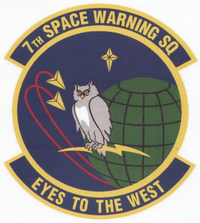7th Space Warning Squadron
| 7th Space Warning Squadron | |
|---|---|

7th Space Warning Squadron emblem
|
|
| Active | 1992-Present |
| Country | United States |
| Branch | United States Air Force |
| Type | Space Operations |
| Role | Missile Warning |
| Part of | 21st Space Wing/AFSPC |
| Garrison/HQ | Beale Air Force Base |
| Decorations |
|
The 7th Space Warning Squadron (7th SWS) guards the U.S. West Coast against sea-launched ballistic missiles from the eastern outskirts of Beale Air Force Base approximately 8 miles (13 km) east of Marysville, California. The 7th SWS is a geographically separated unit of the 21st Space Wing, Peterson Air Force Base, Colorado Springs, Colorado.
The 7th SWS is primarily responsible for detecting submarine-launched ballistic missiles (SLBM) fired in the Pacific Ocean. The unit then determines how many missiles in flight, probable destination, and reports to the North American Aerospace Defense Command's missile warning center, Cheyenne Mountain AFS; United States Strategic Command, Offutt Air Force Base; and National Command Authority. This unit helps form a two-layered, worldwide network of missile warning systems that also detects ICBMs launched toward North America.
Speed is a key factor in day-to-day squadron activities. Within 60 seconds after detecting a launch, the crew on duty has to determine if the detection is valid, under investigation, or anomalous due to computer, mechanical or personnel error. After that, the crew determines the number of launched vehicles and provides impact predictions on North America. Once the information is determined, the unit passes updates to the appropriate authorities.
The 7th SWS's corollary mission of Missile Defense supports the Ground-Based Midcourse Defense (GMD) element of the Ballistic Missile Defense System. This program's objective is the defense of the United States against a threat of a limited strategic ballistic missile attack. The unit's Upgraded Early Warning Radar (UEWR) detects, acquires, and tracks inbound missiles to provide the necessary data to classify and engage the target. This target data allows the GMD Fire Control and Communications element to generate a weapons task plan, allowing for the engagement, interception, and negation of threat of a ballistic missile reentry vehicle in the exoatmospheric region of space.
...
Wikipedia
